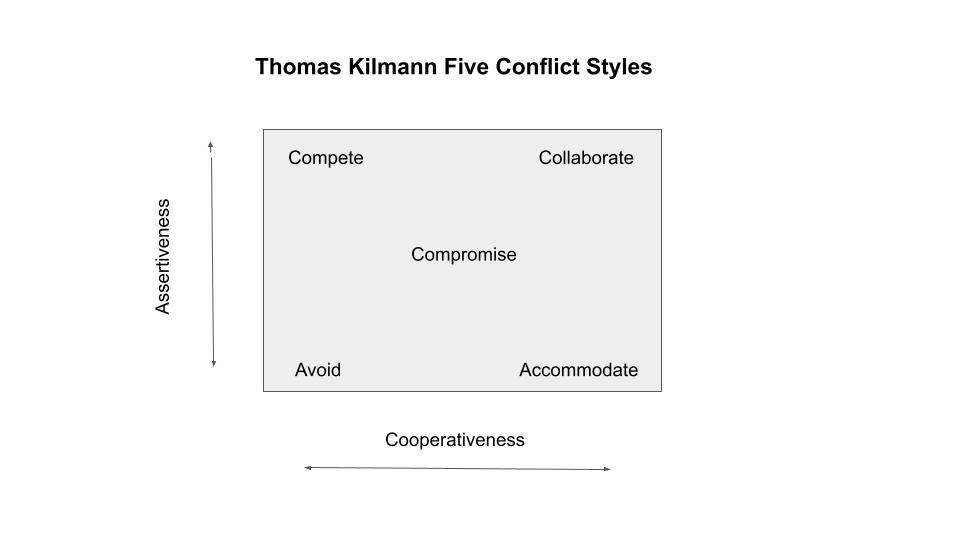Your life is and will be about relentlessly becoming the Self you were born to be – unless you throttle yourself so thoroughly you are unchangeable. If the current You could resolve or manage the conflict well, you would be. If that’s not happening, ask “What do I need to learn about myself, to develop, so I can manage this and similar conflicts in the future?” This blog looks at Conflict Management Styles and how they serve you in skill development. Styles also help you determine if you need to withdraw from an unworkable situation.

Photo Credit: Sean Robertson
Conflict occurs at your EDGE – wherever in you there is something unresolved, a past trauma, a puzzle still to be worked to completion. Life will provide opportunity after opportunity to choose to Engage, first with yourself and then with the Other involved. If you choose not to Engage, the next opportunity will be more pressing, more difficult, more complex, demand more energy. You may have a tougher conflict partner calling for Engagement at the Gate where you are standing.
Long before going to the D for Discussion in a conflict’s EDGE, I am recommending an assessment of both the situation and yourself. On a journey like this one Baggage can’t be checked at the Gate In. The baggage is your map to the Status Nascendi… the birthplace… the Root of the conflict you are being encouraged – forced? – to manage. Remember that your Baggage creates trailing hooks that you connect to others trailing similar hooks. Opportunities to grow are and will continue to be everywhere.
Five Conflict Styles equal Five Attitude Assessment Keys
The most useful tool I’ve found in decades of working through conflicts within myself and coaching/consulting others is Thomas Kilmann’s Conflict Styles Instrument. It was developed in the early 1970s by Ken Thomas and Ralph Kilmann, building on earlier 5-modes work by Blake and Mouton in 1964. There are five styles, visually positioned in a square:

These five styles can be used to assess the percentage of success you have in resolving or managing the conflict. There are also five “outside the box” or “shadow” styles that require an entirely different strategy. First, let’s explore the five healthy styles that all people have available to use, though many people unconsciously use only one or two.
The Competing style is at the top left, high on the Y-axis Assertiveness. Accommodating is in the opposite corner, at the far right of the X-axis: Cooperativeness. At the other end of both scales is Avoiding style. At the far right corner is Collaboration, which style involves both high Competition and Accommodation, and in the middle is Compromise, which involves a little bit of the other four to achieve a resolution.
All Five Styles are Useful
The most powerful component of this tool is that all five styles are useful, but are applied in different conflict situations. This means a person skilled in all five conflict styles can diagnose and use the style most useful to working through a conflict in different situations. Depending on your conflict partner’s style, you can meet or adapt your own style in order to help manage the conflict.
These are the skills to have:
-
- You know and effectively use your primary and secondary Styles, and have some skills in the other three.
- You know how to assess your conflict partner’s Styles, and how to adapt your styles to shift the expected communication pattern(s).
- You use Styles to create novel environments for both you and your conflict partner, thereby Engaging the partner’s curious and problem-solving brain.
With these skills the ability to manage and even resolve a conflict increases exponentially. Even more useful is that someone who has these five styles available to adapt to a potential conflict actually defuses it before it tears people apart.
To Take the T-K Instrument
Typing Thomas Kilmann Conflict Instrument in Search will yield a lot of useful information. Here is the link to Ken Thomas’ site. And here is the link to the diagnostic assessment if you want to take the Conflict Mode Instrument to discover more about your conflict styles.
Using Styles in Your Personal Assessment of Conflict Situation
If your conflict partner’s styles include any position on the X-axis (Accommodation, Compromise, Collaboration) you have a solid chance of resolving the conflict. You have to pay attention and do your part.
Accommodation: If you both are high accommodators the conflict may be buried and involve some digging on both your parts. Your work is first to express what you want for yourself and what you want from your conflict partner. You may need to help your accommodating partner express wants and needs, rather than just accommodate your wishes and potentially bury the conflict under another layer of private resentment.
Collaboration: The task for both conflict partners is to hold to their own truth (Competition) and to equally listen, understand, and attempt some accommodation of the conflict partner’s truth. Often by engaging in a collaborative process the conflict shifts for both partners as a third, new opportunity for both appears that neither thought of before.
Compromise: Best used in low stake conflicts because both partners lose a little, both win a little, and neither is truly satisfied. If you don’t care that much about the outcome this is a good style, e.g. buying/selling something. “You get A and I get B, O.K.?”
If you or your conflict partner’s styles are either Competing or Avoiding your chances of successful resolution go down. The Competing Style partner has difficulty moving position because it’s experienced as losing. The Avoiding Style partner has little ability to consider Engagement, and most probably won’t show up for the conversation. There are ways to work with these styles but only if the person is aware and willing to 1) Engage and 2) Listen and 3) Generate a Solution that works for both. If you don’t experience your conflict partner as capable of any of the three, you wisely may choose not to Engage at all, and work instead on your emotional trigger(s), so you live free of the conflict. If you must Engage, you need allies. We’ll explore Allies in the future.
Non-Healthy Style Applications and Necessary Boundaries

We are going further on than Ken Thomas and Ralph Kilmann did in their explorations. The minute we move “across the line” and “outside the box” on the model we shift to a defensive position, whether perpetrator or victim. Culturally it is easier for us to understand how a Competitor style might become abusive – winning is more important than any other consideration. Avoidance as a pairing with an abusive Competitor style can often be described as Victim behavior. But these roles can be switched; for example, a person who insists on Avoiding a conflict is experienced as a perpetrator by the other styles. A person who only Accommodates may perceive themselves as a peacemaker until they realize they’ve lost too much.
When I began to work with this instrument in the 70’s many managers were survivors of WWII. A Collaborator was someone who aligned with the enemy. The very idea of working with the “enemy” in a conflict situation meant they were colluding with a different, and perceived as evil, set of values. This view of collaboration may exist in any person subscribing to a deep but different belief. We’ll come back to this discussion in the upcoming blog on Values (another source of conflict). For our purposes here, in Attitude Assessment, consider if your conflict partner has a belief that to shift in any direction might be seen as collaboration with evil. To step back over the line and begin to collaborate may cost your conflict partner the entire platform on which they have built their life, and make them an outsider, even pariah, in their relationship web.
When everyone in the room uses a Collaborator style the movement to cohesion may be quick, and not enough discussion discovers the problems relevant to this new position. It is for that reason that Presidents Lincoln and Obama selected cabinet members from opposing points of view in order to understand as much as possible about any situation. In our current political situation of opposing Competitors, the idea of Collaborating is seen as “consorting with the enemy” and the cost for a solution conversation is very high.
Along the “Outside the Box” X-axis is the person who Accommodates in every situation. This style is visible when a person sending several non-verbal messages replies “Fine” when asked, “How are you?” When asked “Where would you like to go?” or “do”? the response is “Whatever you want.” Too often this leads to a post-conflict position I call Niggling (my personal term – feel free to make up your own word): chipping away at the agreement with constant whines or small bites like “I didn’t really want to… “ If you have ever been on a vacation trip with a person who “accommodated” your choice, you will hear about every hot or rainy day, every step to a destination they didn’t choose, every meal served, etc. This Victim tactic: being dripping water wearing on a rock.
Finally, it is visually difficult to imagine how the middle position of Compromise can be “outside the box”. This may tell us why it is the fall-back position in so many arguments. “We will never agree so let’s just compromise.” In most cases, the person with the least to lose initiates this request, and neither person is satisfied with the outcome. When principles are sacrificed in order to resolve the situation, the conflict probably will arise again, either to redo it or to have a related conflict about how the first conflict wasn’t satisfactorily resolved. The compromise even can become the lead-in reference to entirely new conflicts…. “Do you remember when you…”.
It is very important to assess whether or not your conflict partner operates “outside the box” and has over-the-line behaviors. It’s also important to realize if you operate there and have over-the-line behaviors. Many conflicts with similar themes may be indicating that you are experienced as dangerous by others.
Assessing Your Conflict
Edge Conflict blogs #7, 8, and 9 are about one of the causes of conflict: Attitude. This blog enables you to consider which Styles of conflict management you use, and which you need to practice to gain skill at using. As you apply the same assessment to your partner in the conflict you may discover you both are capable of having a truthful and productive Discussion. If this is the case, together you can manage this conflict EDGE. Remember this is an EDGE for both of you; your trailing hooks of baggage are connected, and you’ve given each other this opportunity to work through the issues.
If you don’t assess your partner as being able to adapt conflict styles and move towards a solution, there are a few steps to take:
-
- Confirm: it will be useful to check with others who know you both. You may hear “Oh, yes, he manages conflict really well – except with you….” or “I think she’s incapable of having a problem solving conversation with anyone. It’s her way or the highway.” Beware: some people are quite pleasant with others and save all their negativity for you.
- Learn and Practice: if there are things you need to learn, like different styles, don’t practice first with your conflict partner. Small opportunities present themselves daily; try using different styles in low risk situations. Role play the conversation with a trusted, neutral ally. Study skillful other people and how they employ the styles. Work on it: the fact that you will manage the target Discussion with a new set of styles may be the breakthrough needed for settling the argument.
- Set Boundaries: if you determine that your conflict partner operates in the “out of the box”, negative style area, care must be taken.
If you know entering into a Discussion that you will be defeated/eviscerated – why begin? You can withdraw from the conflict, lay it down, disengage. If that seems impossible, you fruitfully can explore why you see it that way. If you must “win” on this issue, ask yourself “Why?” There is no need to inform the person you are doing this; if you feel you must “tell them” ask yourself “Why?” Explore your motivations for remaining in this unproductive conflict.
Can you practice loving this person just as they are, or, as the Friends say, loving “that of God within” the person. Can you employ the Avoidance style while still standing upright in any shared environment? When you move both the conflict and the person to neutrality within, you cease to think/worry about the conflict anymore. If forced into a confrontation, turn it into a learning opportunity, or a reinforcement that this conflict partner is beyond your skill and get out.
The next blog, #9 – Unto All Generations (Ancestors/Descendents), explores one other area to research before you Engage in a Discussion – it’s another view of how to hone your Edge.
Can you determine your EDGE in terms of Styles?
Can you practice new Styles in low-risk situations, and reward yourself for learning?
Can you base your Attitude towards conflict in a confidence in your ability to use various Styles depending on the conflict and the conflict partner?
EDGE: Root & Web
Exploring Conflict as Transformer.




